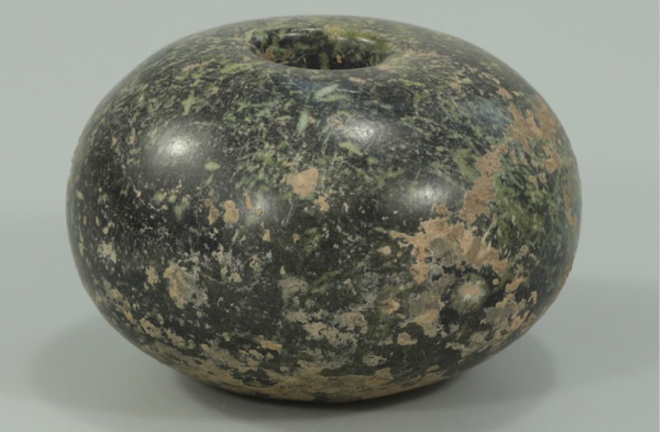Mace heads decode early Eurasian exchanges

A jade mace head unearthed at the Gedachuan site, Gansu Photo: COURTESY OF LI BINSEN
Archaeological discoveries affirm the interactions among prehistoric populations and cultures, evidenced in part by the widespread distribution of mace heads across the Eurasian continent. Originating in Mesopotamia around ten thousand years ago as stone tools or weapons, mace heads evolved into various forms over millennia as they spread across Eurasia. Ancient mace heads have been unearthed in China during the last century. It is worth exploring how these artifacts were distributed and transformed at the eastern end of Eurasia, and their role in cultural exchange within Chinese history.
Temporal and spatial distribution
The earliest mace heads found in China are discussed in Li Shuicheng’s work, The Origins and Dispersal of Mace Scepters, which suggests that the earliest mace heads discovered in China were found in Gansu, crafted from painted pottery and white marble. In 2022, a jade mace head discovered at the Gedachuan site in Gansu, further confirmed the early presence of mace heads in China. This discovery prompts a reevaluation of the interactions between the civilizations of Western China and Central Asia around 6,000 years ago, suggesting they may have occurred earlier than previously thought.
In China, the spatial distribution of mace heads appears to correlate with specific cultural spheres. Historian Chen Shengqian delineated prehistoric China into four distinct regions: Northwest Inland [comprising the three subregions of the Qinghai-Tibet Plateau, the Mongolian Steppe, and the Desert-Gobi Oasis], Southeast Hinterland [encompassing Northeast China, North China, the middle and lower reaches of the Yangtze River, Lingnan, and Southwest China], the Northeast-Southwest Transition Zone [a transition area between forests and grasslands], and the Coastal Zone [a transition area between land and sea]. Chen argued that interaction between the northwestern and southeastern regions occurred indirectly, facilitated through the Northeast-Southwest Transition Zone. Coincidentally, the distribution of mace heads predominantly overlapped with the Northwest Inland region and showed limited penetration into the Southeast Hinterland, which relied heavily on agriculture. This suggests that the use of mace heads was more aligned with the nomadic life style.
Hidden technological choices
After clarifying the distribution characteristics of mace heads in northern China, a subsequent question arises: why were mace heads, a commonly used artifact in ancient Eurasia, rarely found in the Central Plains of China while technologies like wheat cultivation, horse breeding, and metallurgy from Western Asia were readily adopted and innovated upon in the Central Plains? Professor Jessica Rawson observed that the spatial and temporal distribution of mace heads overlaps significantly with that of stone axes with holes for installing handles, bronze short swords, and daggers. She posited that the main reason for the disparity may lie in the combat style associated with these weapons, which were not suited for adoption in the Central Plains. While the Central Plains readily accepted the productivity advancements represented by wheat and metallurgy, the military technology and individual combat methods represented by mace heads were not suitable for this area. Mace heads and individual combat, which emphasize personal achievements, remained popular in north Eurasia, while the agricultural civilization of the Central Plains, benefiting from a large population achieved through settlement, tended to prefer a collective infantry combat mode. These two military traditions, shaped by different economic foundations, formed a stark contrast between the two regions.
While both West Asia and China are among the earliest originators of agriculture, West Asian agricultural systems lack the continuity seen in China. China’s stable agricultural practices over millennia have supported the continuity and accumulation of its civilization. The southern boundary of the spatial distribution of mace heads aligns with the buffer zone between nomadic and agricultural economies. The advantage of nomadic culture lies in its rapid mobility, allowing it to swiftly traverse vast territories. However, in terms of the depth of cultural transmission, settled agricultural civilizations surpass nomadic economies in social productivity, population scale, and social organization. Consequently, cultural elements like mace heads largely failed to permeate agricultural civilizations. The study of mace heads provides a unique perspective on material culture transmission, outlining the long-standing cross-regional cultural exchanges in prehistoric times.
Li Binsen is a lecturer from the School of History and Culture at Henan University.
Edited by REN GUANHONG
